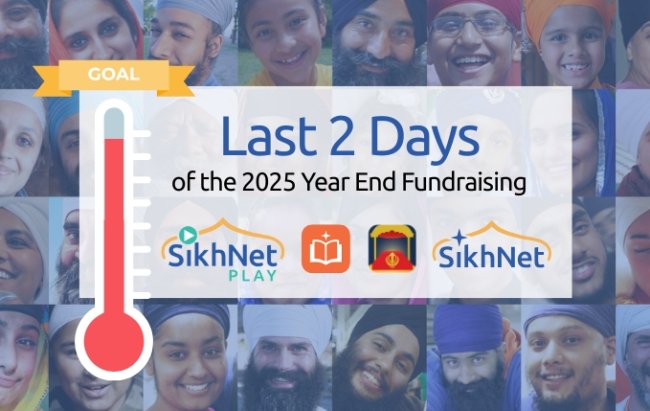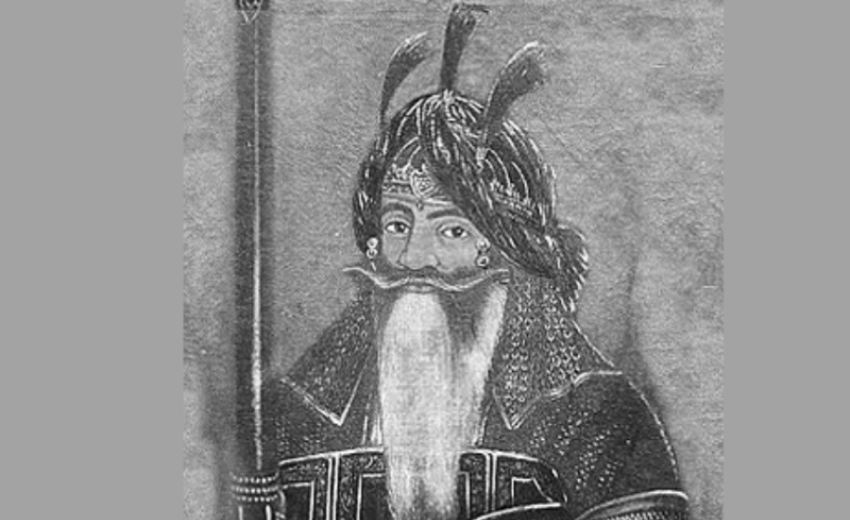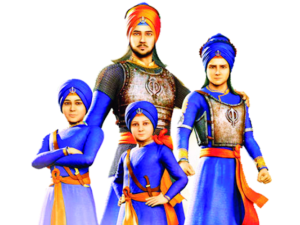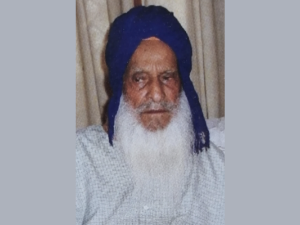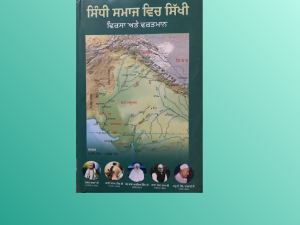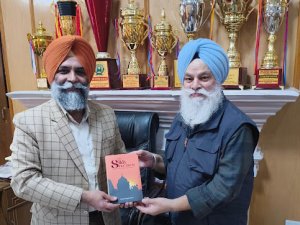The name of lionhearted Sardar Hari Singh Nalwa (1791–1837) is one of the most revered and loved names in Sikh history. If Sher -i -Punjab Maharaja Ranjit Singh was a policy maker, then Nalwa Sardar was an adventurous commander -in -Chief of the Khalsa Army, who implemented those policies face to face. Sardar Hari Singh's bravery, courage, fearlessness and benevolence were unparalleled. He was known for his dauntless courage, unique chivalry. Historians recognized Sardar Hari Singh Nalwa as the most successful army General of the world.
Sardar Nalwa was a confederate of the Khalsa state who was far-sighted and an administrator, a successful personality and a beacon of virtue. Its confluence, wisdom and foresight prevented eight consecutive centuries of Afghan aggression. He was so proficient in guns, archery , swords, spears, bombs, cannons, bayonets and horsemanship that achieving victories for the Sikh kingdom became a virtue of his deeds. Sher i Punjab, when he saw Sardar Hari Singh killing a Nal (lion), bestowed upon him the title of Nalwa. The battles of Attock, Kashmir, Kasur, Multan, Hazara, Nowshera and Peshawar with which Sardar Nalwa fought valiantly is a golden chapter in Sikh history. Among the Pathans and Afghans, Sardar Hari Singh Nalwa’s name was so terrified that when Afghan children would not stop crying,the mothers frightened their children, stop so “Hariya Rangila”(meaning child, shut up, Hari Singh is coming). This is also confirmed by Olaf Caroe in his book.
MARCH TO KASHMIR:
When the Khalsa forces marched in 1814 CE, Sardar Hari Singh Nalwa was commanding the Khalsa forces when he invaded Kashmir. When Shah Shuja was defeated by his brother Shah Mahmud and reached Attock, Jahan Khan was the Kiledar (fort keeper) of Attock. He captured Shah Shuja and sent him to his brother, Atta Mohammad Khan, the governor of Kashmir. From Kabul, Wazir Fateh Khan was following Shah Shuja. When he was informed that Shah Shuja was in Kashmir, he invaded and sought the help of Maharaja Ranjit Singh. He assured that half of the plunder of Kashmir and nine lakh rupees would be given to the Khalsa forces. On the other hand, Shah Shuja’s Begum (wife) sent a messenger to Maharaja Ranjit Singh that if her husband would be returned safe from Kashmir, She will present kohi Noor diamond to Sher- i -Punjab. Maharaja keeping both the above points in mind and at the same time considering that the Khalsa forces will be aware of the route to Kashmir,ordered the troops to March towards Kashmir.
“The joint Sikh-Afghani expedition to Kashmir was undertaken in 1812 "(Parmu, 1977, P 47). On one hand wazir Fateh Khan proceeded to Kashmir along with his army and on other side Sardars Hari Singh Nalwa, Sham Singh Attari, Dewan Mohkam Chand, Dal Singh and Jeevan Singh along with 12,000 Khalsa troops reached Srinagar via Bhimber, Rajouri and Peer Panjal and Muhammad Khan's forces fought hard. During possession of Shergarhi a battle was fought in which some soldiers were killed on both sides.The Khalsa forces cremated the Sikh soldiers at the site of Shaheed-Ganj. (Where Bunga is now the shrine of Akali Phula Singh).
The Khalsa forces captured Shergarhi, freed Shah Shuja from captivity and took him into their custody. The Khalsa forces demanded from Wazir Fateh Khan half of the booty and nine lakh rupees as promised. The Khalsa forces came to Lahore with Shah Shuja and Wafa Begum presented the 'Kohinoor Diamond' to Sher i Punjab.
To conquer Kashmir, the Khalsa forces marched on 20 April 1819 departed from Lahore. In this campaign, Sher i Punjab divided the army into three parts. The first vanguard was that of Sardar Hari Singh Nalwa, Prince Kharak Singh and Akali Phula Singh. In the second squad, Diwan Muhakam Chand, S. Sham Singh Attari, S. Hukma Singh Chimney, S. Jwala Singh and others. Sher i Punjab has a reserve force of 10,000 so that help can be sent when needed. When the Khalsa forces from various directions broke like lightning on the morning of July 3, 1819, in the field with the forces of Muhammad Jabbar Khan, the ruler of Kashmir, in the field of Shupian, a fierce battle took place under the shadow of the chants of 'Sat Sri Akal'.In the battlefield,When Nawab Jabbar Khan, began to attack Nalva, Sardar Nalva hastily cut off Jabar Khan's left hand with his sword. Nawab seriously injured and fled to Afghanistan via Muzaffarabad, hiding in the border mountain passes along with his troops. Thus, after nearly five hundred years (1325 AD to 1819 AD), the flags of Khalsa independence began to fly on the beautiful land of Kashmir.
In this battle a large quantity of Afghan ammunition came to the hands of the Khalsa. “Thousands of swords, guns, bayonets, horses, tents, etc. came into the hands and 22 cannons (18 were fit for use) came into the hands of the Khalsa. (Prem Singh Baba, 1937, p 104). In this battle many soldiers were killed. There, a dozen soldiers of the Khalsa forces also achieved martyrdom, including the brave Sardar Jodh Singh Rusa. Khalsa forces with high spirits celebrated an impressive victory
entered the city of Srinagar on the afternoon of July 4, 1819. Prince Kharak Singh proclaimed throughout the city that no citizen need be alarmed as the Khalsa Army had come to the rescue of the Kashmiri people. It is said that when the procession passed through the city, people were watching the strange spectacle with joy and amazement. The Kashmiri people not only welcomed the Khalsa forces but also showered flowers. Prince Kharak Singh encamped at Shergarhi fort and stationed the rest of the chiefs and troops at suitable places. News of the victory of the Khalsa forces in Kashmir reached Sher-i-Punjab in 'Shahabad'.Fast-paced Khalsa Panth’s well known informant S. Jamal Singh 'Lamtange' was sent. Sher-i-Punjab was overjoyed to hear this news and donated one lakh and twenty-five thousand rupees to Darbar Sahib, Amritsar for the prayer of thanksgiving. Following the orders of Sher-i-Punjab, after fierce battles, Muzaffarabad and Darband regions were merged into the Khalsa Raj. (Mohammad Latif, page 419)
There was military rule in Kashmir for a few weeks.Dewan Ram Dayal was appointed in Bhimber, Bhai Ram Singh Pargan-i-Dar of rivers,S.Sham Singh Attari, S. Jawala Singh and Misr Diwan Chand were appointed administrators of Baramulla and Srinagar. General Sardar Hari Singh Nalwa was appointed Supervisor of the entire army. By appointing Diwan Moti Ram as the first Governor of Kashmir, keeping small army in Kashmir for a while, Sardar Nalva took the rest of the army to Lahore. When this victorious army reached Lahore, Sher-i-Punjab led this army near Shahdara. When the Khalsa forces reached Lahore, riding on elephants and horses. It was a procession of Khalsa glory. When Sardar Nalva's elephant entered the Lahore gate, people rained roses, kewra and flowers from the roofs of the houses. A salute was given with large cannons and a candle was lit in the city of Lahore at night. On the second day, Sher-i-Punjab conducted a huge Darbar in the beautiful Hazuri Bagh to pay homage to the winners of Kashmir.
The Kashmir winners were facilitated with priceless gifts and khelats. To Sardar Nalwa, Dhoni's entire territory was gifted as a jagir. For less than a year, Moti Ram could not fully manage the governorship. During this time unrest, violation of government orders, incidents of loot had reached their peak. Initially, She-i-Punjab sent Diwan Devi Das of Peshawar to Kashmir for investigation. Devi Das submitted a report to the Maharaja. When Maharaja received a complete report on Kashmir, then he took decisions that no one can make Kashmir clean without Sardar Hari Singh Nalwa. Thus Sher-i -Punjab deputed Sardar Nalwa as the Governor of Kashmir.
GOVERNANCE ADMINISTRATION:
Ideal of the Sikh Empire Famous Adventurer and Khalsa army’s Mir-i - Karwan of Struggles, Sardar Hari Singh reached Srinagar on August 24, 1820. On 25 August, took over the governor charge from Diwan Moti Ram. “Informing Kashmir of the deplorable situation, the Maharaja nominated Sardar Hari Singh Nalwa as the Nizamat of Kashmir. “(Mohammad Din, Part 3, p 16). Hari Singh Nalwa first checked the treasury documents and found that the collection of revenue and salaries of the troops had been suspended for four months. Looting, robbery, quarrels and massacres were at their peak and the people had reached the brink of revolt.
DECLARATIONS FORE.
There was no room for such irregularities for a general who was a staunch fighter, loyal and unwavering to the Sikh state. The very next day, the Sardar informed the people in writing and in all the cities that “The Khalsa had established the Khalsa state in Kashmir after great sacrifices. Therefore, the people of Kashmir should be treated in good faith and the people should cooperate. Revenue should be deposited in the royal treasury before any austerity measures are taken. Even after the proclamation, if the government finds out that someone is obstructing it, it will not be good for the people.” Simultaneously he ordered revenue reforms and instructed farmers to “liquidate their arrears or face dire consequences "( Parmu, p. 121)
According to historians,these steps had a profound effect and in a short time Sardar Hari Singh Nalwa was emerged to be an efficient administrator of the Kashmir.
DEDUCTS REVENUE .
The wise and efficient administrator Nalwa Sardar reviewed all the old and new records of revenue and realised the new proposals of revenue which has earned him the respect of historians of the world for his ability and wisdom.
“According to Aina Akbari, the tax of Kashmir was 3011619 Kharwar which was equivalent to an estimated Rs. 1552825. During the rule of Afghans, the revenue was estimated at Cilki Rs. 60,00,000. During the reign of Khalsa Raj, Diwan Moti Ram proposed Rs.21,00,000 Nanak Shahi. Sardar Hari Singh Nalva deducted another Rs. 800,000 from the Diwan's revenue and left only Rs. 1300000 "( Prem Singh, Baba,P:118-119)
Sardar Hari Singh collected all the remaining revenue from the people and sent Pandit Birbal Dhar, Pandit Sajram Dhar, Mirza Pandit Dhar and Khwaja Munwar Dhar to the Lahore Darbar. Unfortunately, all the members of the delegation died except Pandit Birbal Dhar (due to cholera) near Hast Nagar, Rawalpindi. Birbal presented all the accounts in the court and established his reputation.
RESTRICTIONS ON VAGAR CUSTOM:
From time immemorial, a negative and cruel custom of 'Vagar' has been prevalent in Kashmir. It is also mentioned in Kalhan Pandit's book 'Rajatarangini’. Whenever government work or military equipment had to be transported from one place to another, thousands of oppressed and poor Kashmiris were caught and taken to work. Whenever the time came for harvesting, etc., these poor people used to join hands with the Parganadars and Chaudharis and take bribes for bandhkulashi. Their plea was ignored, on the contrary, it was widely harassed. When Sardar Hari Singh saw the scene with his own eyes in many places, he inquired and postponed his visit. The Nalwa Sardar immediately issued instructions and a special proclamation to save the Kashmiris from the disease of vagar. The famous tourist Bernier wrote that the city of Pattan was built by Shankar Verma with the help of this ‘Vagar 'work'. When King Aurangzeb came to Kashmir in 1664, he captured 30,000 Kashmiri vagars and transported all the royal equipment on their backs from one place to another throughout Kashmir.
AGRICULTURE,SHALBAFI AND PASHMINA:
Before the arrival of Sardar Hari Singh Nalwa in Kashmir, crops were completely destroyed due to floods and bad weather. Farmers did not have enough seeds to sow. When Sardar Nalva saw the pitiable condition of Kashmiris, he immediately visited Rajouri, Poonch and Muzaffarabad.
He immediately brought about 2000 hardware paddy from Rajouri, Poonch and Mazaffrabad and distributed them among farmers and Zamindars at cheap rates.
This paddy was sold earlier Rs 16 per family, but Sardar Nalwa distributed paddy seeds at Rs 3 per family and also stopped the tax on the new crop. Thus in 1821 AD. the paddy crop in Kashmir has grown surplus over the last twelve years and has been growing year by year simultaneously.
Shalgaphi work in Kashmir was almost stopped during the Afghan rule. Due to the sharp intellect of Sardar Nalwa, Shalgaphi came back to its first position .Shalgaphi workers were given all assistance and moral support and again flipped their ancestral occupation.The Nalwa Sardar immediately waived the tax.
The first production of pashmina was a quarter of what it was during the Afghan period. Sardar Nalwa greatly reduced the tax on pastures from herdsmen, shepherds and gave them financial assistance.
STORMS,SAILORS, HANDICRAFTS AND SAFFRON:
After the days of Nowruz (1821 AD), torrential rains lashed the Kashmir Valley, causing many dams to collapse, many bridges to collapse and causing heavy loss of life and property in many places. Especially the bridges of Khanyar Mohalla, Pampur, BejBihara, Rainawari, Kavadora, Khanabal etc. were also damaged. Sardar Hari Singh Nalwa not only rebuilt the new bridges but also provided financial assistance from the royal treasury for the construction of new houses, livestock etc. to the Kashmiris. To meet the food shortage, thousands of kharwars of food grains from Punjab imported and distributed them among the needy Kashmiri’s at cheaper rates.
The Kashmir has been an important destination for aquaculture farms. They used to grow vegetables, flowers and fruits on which the government levied heavy taxes. Sardar Nalva not only gave considerable tax relief but also expanded their farms by giving thousands of rupees to the government exchequer.
Kashmir saffron was considered world famous. It has been cultivated since ancient times and has a unique history. 1800 AD After that, its sowing was very limited. Most of its cultivation is in the area of Pampur. Sardar Nalwa paid special attention to the cultivation of saffron. A large gathering of landlords in the area inquired about the stagnation in its sowing. Landlords elaborated on the severity of government levy, lawlessness, looting of saffron beds, theft, poor financial condition etc.
Then Sardar ji not only removed all the weaknesses but also helped to increase the economic conditions of the farmers. In this way, the artisans of paper-making skills were given a lot of financial support from the royal treasury and they were able to stand on their own feet. Kashmiri paper was much better than other countries. Sherjangi, Kalamdani, Hastmasti, Dah Masti and Hari-Riya varieties of paper were considered very popular and good.
Sometime later, when Sardar Nalwa freed himself from the interior administration control of the Kashmir, he conquered Pakhli, Dhamtaur,other areas and annexed them to the Khalsa Raj in April 1821. In May 1821, Sardar Nalwa, through his scribes Sehaj Ram, Pandit Mirza, Khwaja Manohar Shah, Chandra Bhatt, etc, sent all the accounts of his governorship to Lahore, including Farda, registers, etc., to Maharaja Ranjit Singh of Sher-i-Punjab, so that the Maharaja have a glance, the progress of Kashmir. Maharaja Ranjit Singh was overjoyed to see the reckoning and not only praised Sardar Nalwa, but also bestowed precious khellets . According to the author of 'Muqmal Twarikh Kashmir', he presented a chained elephant, a precious necklace and a pair of gold bracelets. The entire area of Pakhli was handed over to Sardar Hari Singh Nalwa as jagir by Maharaja Ranjit Singh.
REFORMATION OF KHAKHAS AND BAMBAS:
The peculiarity of lionhearted, Sardar Hari Singh Nalwa was that he was confronted in the battlefield with the desire of religious war. His name not only stirred the ranks of Afghans and Pathans, but also shook the ranks of rebels and tyrants.
The prominent leaders of these Khakhas and Bambas were Tarbuland Khan, Muzaffar Khan, Ghulam Ali Khan, Sharandaj Khan, etc. who became very rebellious at the very beginning of the Khalsa rule in Kashmir. During the time of Dewan Moti Ram, they never paid a single penny in the government treasury and nor did they follow government orders. Secondly, they also had the backing of the Afghans. Sardar Hari Singh Nalwa first came and refined them in the Baramulla area. “He not only collected the arrears of revenue from them but also recovered the war ransom at the rate of Rs. 5 per household. After this, on both sides of the Jhelum, Sardar Ji along with Sardar Tek Singh (son of S. Sham Singh Attari) and S. Hukma Singh Chimney with a platoon of infantry, one night raided their villages and arrested all the prominent leaders and inflicted such educational punishments on many that all the others got back on track. ” (Walter Lawrence,The Valley of Kashmir,)
Their chief leader was handcuffed and sent to Sher-i-Punjab in the city of Lahore under the supervision of a large army. Sardar Nalwa not only recovered all the revenue from them but also confiscated all the weapons as punishment. Apart from these, he also cleared the rebels in other small areas. When all this news reached Sher-i-Punjab at the Lahore Darbar, he was overjoyed and sent a special order to Praised Hari Singh Nalwa.
COINS, MEASUREMENT AND ESTABLISHMENT OF COURTS:
Sardar Hari Singh, an efficient administrator in Kashmir, a proponent of powerful construction, far-sighted, a champion of the Khalsa and the pride of the Sikh state, the Lion of Punjab Maharaja Ranjit Singh feels so proud that for the first time in Kashmir by special order, Sardar Hari Singh Nalwa was given the right to issue a coin in his name.
On one side of the coin was inscribed in Persian letters 'Sri Akal Sahai and Samat 1878' and on the other side was inscribed 'Hari Singh' and below it was inscribed 'One Rupee' (Walter -The Valley of Kashmir, P. 905).
Hari Singh Rupee is very popular in Kashmir till date (1890 AD) and this coin called Hari Singhia Rupee which he issued in Kashmir. To this day it runs everywhere in Punjab too. (Raisni-Punjab, p.191)
Similarly, Maulana Mohammad Din also writes in his book, “Hari Singh also issued a coin of his name in Kashmir which became famous by the name of Hari Singhia. What a price it was today to pay eight annas. There are many people till (1912 AD) who look at Hari Singhia paisa and Hari Singhia rupee. Silver coins called Hari Singh Singhia Paisa were also issued. These coins were minted in 1821 at Srinagar. In rupees 10 mashe was pure silver in rupees. In this way he established a mint on behalf of the Sikh Empire to facilitate revenue collection in Kashmir and Peshawar.
Sardar Nalwa ordered uniformity used measurements and scales at all places and he ordered people to do the same. The measurements were usually as follows: 17 tola equal to one paa ,6 Paa or 1.5 seer equal to manuta,4 manuta one Trakh and 16 trakh or 96 seer equal to one kharwar. Police stations were set up at appropriate places to hear the grievances of the people, courts were set up to give justice to the people and verdicts were promptly decided. Good days returned to the landlords and shopkeepers. Kashmiris who were migrated to other places due to timely atrocities, returned in thousands back to Kashmir.
SHUDDHI(PURIFICATION) MOVEMENT:
It is clear from the pages of Kashmir's ancient history that before
1400 AD, the residents of Kashmir were Hindus. According to a historian, the census of Kashmir during Sikh rule was 12,95, 201 in which 93 per cent were Muslims and 7 per cent Hindus. A century of oppression and persecution out of 100 nearly 93 Hindus became muslims . Concerning the forcible conversion of Hindus to Islam, a Muslim historian writes, "Haji Khan tarfon , Hader Shah sun 879 to 880 Hijra yeh badshah eiyesh awar arbab nishatka (nach rang) ka dildada tha. Ess ne Islami rawadari ko bhala dis tha aar hindu ko zabardasti muslman karna shuro kia “. (Islam and Kashmir, Maulana Al-Fadeen, p 22). The castes and tribes of these Hindus and Muslims are still common, such as Kichlu, Koul, Bhat, Sapru,Var , Poshu, Pandit, Naik, Faqr, Tantra, Dar, etc. Sardar Hari Singh met many heads of Hindu families who narrated stories of conversion to Islam by the rulers of the time. After the establishment of Khalsa Raj in Kashmir, Hindus wanted to convert to their first religion (Hinduism) but was reluctant to do so out of fear. Sardar Nalwa, hearing the pleas of these miserable Pandits, proclaimed in all the cities, If any community acts harshly in this work, they will be punished. The miraculous effect of this announcement was that thousands of Muslims, then Hindus and Sikhs converted. Nearly 50,000 Muslims converted to Sikhism and Hinduism and became pure. '(Prem Singh Baba, P. 130)
There was a very miserable custom in the society since the time of Afghans that 'no Hindu could wear a turban on his head or wear shoes on his feet'. (The Valley of Kashmir, page 108). Similarly, no one could ride a horse. This saying was common in Kashmir, 'Butta chuk ke khaasa ditta’(meaning if you are Hindu, I will ride on you). Sardar Hari Singh was shocked to see the plight of the Kashmiri Pandits and immediately declared, “There is no ban on clothing for any class of people in the Khalsa Raj and everyone can ride a horse”. After this declaration, the living conditions of Hindus became very high.
CONSTRUCTION OF SHRINES:
Sardar Nalwa was imbued with Sikh rites from his childhood and youth. From a war point of view, Nalwa Sardar built the forts of Uri and Muzaffarabad and established the settlements of Shaheed Ganj in Srinagar and Guru Bazar (near Shergarhi Fort) where Nihangs and Akalis settled permanently. The Guru Bazaar was inhabited by Sikh Granthis and Hindu Sadhus.
Sardar Hari Singh Nalwa established the historic seven Gurdwaras at Matan Sahib, Gurdwara Chhevin Patshahi Baramulla, Gurdwara Guru Nanak Sahib Hari Parbat, Gurdwara Chhevin Patshahi Kathi Darwaza Srinagar and Gurdwara Chaie Guru Har Rai Sahib, Devi Angan (Srinagar). Sufi also wrote, “He came to Gurdwara Chhevin Patshahi Baramulla and performed Ardasa. Mr. Nalwa attached three villages to the Gurdwara as jagir, namely Janbazpura , Nadihall and Vadera. (Sarna,1997, page 74)
Sardar Hari Singh Nalwa also visited Gurdwara Chaie Guru Har Rai Sahib.Giani Budh Singh writes, “When Sardar Hari Singh Nalwa became Governor of Kashmir,he visited Gurudwara on Sammat 1877. In 1820 AD, he visited Gurdwara Chaie Guru HarRai Sahib Devi Angan Hal bazaar, then happily wrote a jagir of three hundred and sixty rupees. This lease is in the possession of Bhai Sant Singh Ji which was issued on 24th Assu 1878 Bikrami, wrote that Jagir’s caretaker Mutbina was 'Muhiwal Bans Bhai Hari Singh Ji. (ChonveRattan , 1937,p 419). Later on after the demise of Munshi Sant Singh, Jathedar Lachhman Singh took care of the historic Bir of Guru Granth Sahib with utmost care.Now a days,the historic Bir is at Gurudwara Sikh Orphanage, Chief Khalsa Dewan Amritsar. Bunga Akali Phula Singh,where Akali ji resides at Shaheed Ganj also came into existence during this period.
The official residence of Sardar Hari Singh Nalwa used to be in front of Shergari Ghat, while the white-towered house for summer residence was built on the banks of the river Jhelum, which lies between the present S P College and the Nidous Hotel. (Parmu, p. 312). Hari Singh also built a magnificent garden on the banks of the river Jehlum. He also provided financial support to the royal treasury for the construction of many mosques and temples.
FAREWELL:
Sher-i-Punjab was to conquer more territories with the help of Sardar Nalwa, a valiant servant of the Khalsa Raj, to annex them to the Khalsa Raj, who immediately recalled him from Kashmir and appointed Diwan Moti Ram as Governor of Kashmir. Before leaving, Sardar Nalwa visited Srinagar.
Creating original roots in Sikh history, a huge Darbar was held in which prominent Hindus, Sikhs and Muslims came together. Moments spent in Kashmir Nalwa Sardar presented in very appropriate words and also thanked the people for their love and affection. The Head of the Nation elaborated on the services rendered by the Nalva Sardar to the Kashmiris and wished him all the best and blessings.
Preparations were made for the see off of Sardar Sahib from Kashmir on 6 November 1821 AD. Crowds of people on both sides of the road were saying goodbye to their beloved Sardar Nalwa. Nalwa Sardar to all, with folded hands greeting “Wahe Guru ji ka Khalsa.Wahe Guru ji ke Fateh”. Earlier, the sky resounded with the roar of victory by thousands of Kashmiris. Thus, amidst chants, he left Kashmir.
Sardar Hari Singh Nalwa was responsible for expanding the frontiers of Sikh Empire to beyond Indus River right unto the north Khayber Pass. In the time of Sardar Hari Singh Nalwa , prosperity and brotherhood were at their peak in Kashmir. He was regarded as a beloved servant of the people and an efficient governor.
